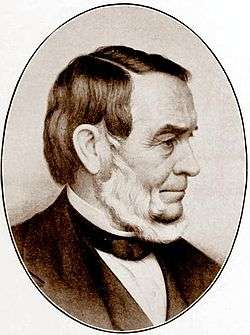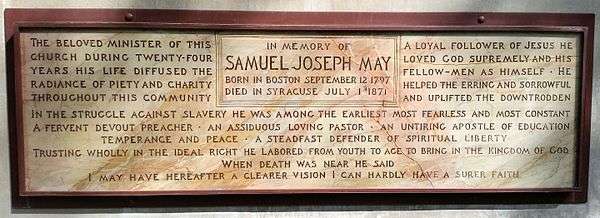Samuel Joseph May

Samuel Joseph May (September 12, 1797 – July 1, 1871) an American reformer during the nineteenth century, championed multiple reform movements including education, women’s rights, and abolitionism. May argued on behalf of all working people that the rights of humanity were more important than the rights of property and advocated for minimum wages and legal limitations on the amassing of wealth. He was born on September 12, 1797, in an upper class Boston area. May was the son of Colonel Joseph May, a merchant, and Dorothy Sewell, who was descended from or connected to many of the leading families of colonial Massachusetts, including the Quincys and the Hancocks. His sister was Abby May Alcott, mother of novelist Louisa May Alcott.[1] In 1825, he married Lucretia Flagge Coffin with whom he had five children.
Education and early career
May was born and raised in Boston, Massachusetts in 1788. When he was four years old his six year old brother Edward died while they were at play in their barn. May claimed that the loss of his brother and the dreams he had following the fatal accident led him to devote his life to God and inspired his passion to "rectify the world's wrongs."[1] He started attending Harvard in 1813 at the age of fifteen;[2] during his junior year he chose to become a minister. In addition, while he was at Harvard and afterwards, he taught school in Concord, Massachusetts. During this time, he met many prominent Unitarians and activists including Noah Worcester, who instilled in May the idea of peaceful opposition. May graduated from Harvard Divinity School in 1820 and became a Unitarian minister. Following his graduation, he considered preaching in New York City and Richmond, Virginia prior to accepting a position in Brooklyn, Connecticut as the only Unitarian minister in that state. Here, he came to the forefront of the Unitarian movement and became well known throughout New England as he attempted to establish Unitarian churches and reform.[2]
Early reform
May began a biweekly publication, The Liberal Christian, in January 1823;[3] its main goal was to explain the Unitarian Theology. He helped in the formation of Windham County Peace Society in 1826; in 1827, May organized a statewide convention for school reform in Connecticut, and he started a series of lectures in 1828. Meanwhile, he also belonged to the American Colonization Society whose purpose was to send the slaves back to Africa. May’s belief in perfectionism through imitating the life of Jesus Christ strongly influenced his involvement in reform movements. A pacifist, he actively participated in establishing peace societies, speaking out against the death penalty, and advocating nonresistance. He practiced this last belief to the extent of rejecting self-defense. He became a leader in the temperance movement, believing it to be a form of abolitionism since he saw men as slaves to drink. He was perhaps most renowned for his work in education reform as he sought to improve facilities, teachers, and curriculum in public elementary schools. May believed schools should be racially integrated and coeducational, and he advocated the philosophy of Swiss theorist Johann Pestalozzi. He spent time tutoring his sister Abigail May in philosophy and the humanities and wrote in a letter to her, "What you say relative to the need for universal education is certainly true. Nothing is of unimportance in the formation of the mind."[1]
Involvement in abolitionism
In 1830, May happened to meet and create a strong friendship with William Lloyd Garrison, which pushed him into the abolitionist movement. Although his abolitionist views alienated his family, friends, and other clergymen, he remained true to his beliefs. He helped Garrison found the New England Anti-Slavery Society, the American Anti-Slavery Society, and the New England Non-Resistance Society, in addition to working for the Massachusetts Anti-Slavery Society.[4] He served as one of the writers for the constitutions of some of these societies, and as a lecturer and general agent for the New England Anti-Slavery Society. Fighting for racial equality and better schools, May defended Prudence Crandall in the 1830s as residents of Canterbury, Connecticut fought her decision to close the school she ran for white girls and open it solely to young black ladies. This experience caused him to abandon his support for the colonization movement. May was one of the delegates from Massachusetts who went to the World Anti-Slavery Convention in London in 1840.[5]
May became pastor of the Unitarian Church of the Messiah of Syracuse, New York in 1845, serving until 1868. He fought the Fugitive Slave Law of the 1850s by making announcements during his sermons of fugitive slaves in the area and took collections on their behalf, as well as aiding escaped slaves along the Underground Railroad. As a prominent abolitionist in the city, May, with the help of many Liberty Party members, including Gerrit Smith and Samuel Ringgold Ward, planned and successfully executed the rescue of Jerry McHenry, a man arrested as a fugitive slave, from the police. In addition to fighting for the abolition of slavery, he fought for the equality of free blacks in his congregations by allowing them to sit in the front as opposed to the segregated rear pews. This act resulted in his reproach by white congregation members and also in his quitting some of his parishes. These actions, particularly late in the 1850s and immediately after President Lincoln was elected in 1860, led abolitionism’s opponents to violently attack May as well as burn him in effigy.
Work for women's rights
In addition to speaking and writing pamphlets and articles concerning abolitionism, May was a leading advocate in women’s rights and suffrage. Most notably, he wrote The Rights and Condition of Women in 1846 in favor of giving women the right to vote and allowing them equality in all aspects of life. May’s work with the women’s movement prompted him to move towards socialist economic views including redistribution of the nation’s wealth, overhaul of the legal system, and a “soak-the-rich” income tax. He published a variety of other writings including "Education of the Faculties" (Boston, 1846); "Revival of Education" (Syracuse, New York, 1855): and "Recollections of the Anti-Slavery Conflict" (Boston, 1868).
Final years and legacy

By the time of the American Civil War, May had long been torn between his commitment to pacifism and his growing belief that slavery could not be destroyed without violence. He felt that the use of force against the Southern rebellion was necessary. Following the war and success of emancipation, May continued his work for racial, sexual, economic, and educational equality until the end of his life, including service as president of the Syracuse public school district.[6]
Samuel Joseph May died on July 1, 1871 in Syracuse, New York. He is buried at Oakwood Cemetery, Syracuse, New York.[7]
Legacy
May donated over 10,000 of his works to the Cornell Library. These articles included pamphlets, leaflets, and other anti-slavery documents. This rare collection at the Cornell Library is considered of great importance so that the literature of the Anti-Slavery movement can be "preserved and handed down, that the purposes and the spirit, the methods and the aims of the Abolitionists should be clearly known and understood by future generations."
In 1885, the Unitarian Church of the Messiah, in Syracuse, was renamed in May's honor to May Memorial Unitarian Church; it is now the May Memorial Unitarian Universalist Society (MMUUS).
See also
References
Notes
- 1 2 3 LaPlante, Eve (2012). Marmee & Louisa: The Untold Story of Louisa May Alcott and Her Mother. New York: Simon and Schuster. p. 2.
- 1 2 Eiselein, Gregory; Phillips, Anne K. (2001). The Louisa May Alcott Encyclopedia. Westport, Connecticut: Greenwood Press.
- ↑ "American Periodical Series: 18th century Guide".
- ↑ Campbell, Stanley (1968). The Slave Catchers: Enforcement of the Fugitive Slave Law, 1850-1860. North Carolina: University of North Carolina Press. p. 155.
- ↑ "List of delegates, World Anti-Slavery Convention, 1840". JSTOR 60228328.
- ↑ Smith, Edward. 1893. A History of the Schools of Syracuse from its Early Settlement to January 1, 1893. Syracuse: C.W. Bardeen. Available: Google Books
- ↑ "Rev Samuel Joseph May". FindAGrave.com. Retrieved 29 July 2016.
Further reading
- Mumford, Thomas J. (1873). Memoir of Samuel Joseph May. Boston: Roberts Brothers.
- Yacovone,Donald. (1991). Samuel Joseph May and the Dilemmas of the Liberal Persuasion, 1797-1871. Philadelphia: Temple University Press.
- Yacovone, Donald. (2000, February). "May, Samuel Joseph," American National Biography Online. Available by subscription: http://www.anb.org/articles/15/15-00454.html.
External links
- Samuel Joseph May. Born in Boston, Massachusetts, September 12th, 1797. Died in Syracuse, New York, July 1st, 1871. Syracuse: Syracuse Journal Office, 1871.
- Samuel J. May Anti-Slavery Collection, Cornell Library
- May Memorial Unitarian Universalist Society
- Dictionary of Unitarian & Universalist Biography
- "Samuel May". Spartacus-educational.com. Retrieved 2016-07-29.
- Edward H. Knoblauch. "Samuel J. May - New York History Net". Nyhistory.com. Retrieved 2016-07-29.
- "Abolitionist Samuel J. May". Pbs.org. Retrieved 2016-07-29.